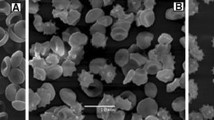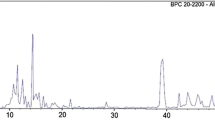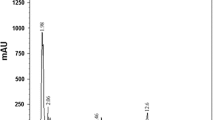Abstract
Gallic acid (GA) is a polyphenol present in many plants. This study was aimed to investigate the molecular interaction of GA with the human erythrocyte membrane and to determine its antioxidant capacity. The molecular interaction with the membrane of human red cells and the antioxidant property was assayed on both human red cells and molecular models of its membrane. Observations by optical, scanning electron, and defocusing microscopy demonstrated that GA is capable to convert red cells from their normal biconcave shape to crenated echinocytes. This result indicates that GA molecules are positioned in the outer monolayer of the red cell membrane. Dimyristoylphosphatidylcholine (DMPC) and dimyristoylphosphatidylethanolamine (DMPE) were selected as classes of phospholipids found in the outer and inner monolayers of the red cell membrane, respectively. X-ray diffraction and differential scanning calorimetry showed that GA was preferentially bound to DMPC bilayers. Experiments related to the antioxidant capacity of GA indicated that this compound offsets HClO oxidative capacity on DMPE bilayers. In addition, optical, scanning, defocusing microscopy, and hemolysis assays confirmed the protective capacity of GA against HClO deleterious effects on human red cells. As a conclusion, GA would be capable to block the access of oxidants into the lipid bilayer, and thus avoid their access into red cells.










Similar content being viewed by others
Abbreviations
- GA:
-
Gallic acid
- DMPC:
-
Dimyristoylphosphatidylcholine
- DMPE:
-
Dimyristoylphosphatidylethanolamine
- SEM:
-
Scanning electron microscopy
- DM:
-
Defocusing microscopy
- DSC:
-
Differential scanning calorimetry
- HClO:
-
Hypochlorous acid
References
Abram V, Berlec B, Ota A, Šentjurc M, Blatnik P, Ulrih NP (2013) Effect of flavonoid structure on the fluidity of model lipid membranes. Food Chem 139:804–813
Agero U, Mesquita LG, Neves BRA, Gazzinelli RT, Mesquita ON (2004) Defocusing microscopy. Microsc Res Tech 65:159–165
Anjana J, Monika B, Shukla S (2007) Protective effect of Terminalis belerica Roxb. and gallic acid against carbon tetrachloride induced damage in albino rats. J Ethnopharmacol 109:214–218
Battistelli M, De Sanctis R, De Bellis R, Cucchiarini L, Dachà M, Gobbi P (2005) Rhodiola rosea as antioxidant in red blood cells: ultrastructural and hemolytical behavior. Eur J Histochem 49:243–254
Bonora S, Markarian SA, Trinchero A, Grigorian KR (2005) DSC study on the effect of dimethysulfoxide (DMSO) and diethylsulfoxide (DESO) on phospholipid liposomes. Thermochim Acta 433:19–26
Boon JM, Smith BD (2000) Chemical control of phospholipid distribution across bilayer membranes. Med Res Rev 22:251–281
Budai M, Szabo Z, Szögyi M, Gro P (2002) Molecular interactions between DPPC and morphine derivates: a DSC and EPR study. Int J Pharm 50:239–250
Carr AC, Vissers MCM, Domigan NM, Winterbourn CC (1997) Modification of red cell membrane lipids by hypochlorous acid and hemolysis by preformed lipid clorohydrins. Redox Rep 3:263–271
Caturla N, Vewra-Samper E, Villalaín J, Reyes Mateo C, Micol V (2003) The relationship between the antioxidant and the antibacterial properties of galloylated catechins and the structure of phospholipid model membranes. Free Radical Biol Med 34:648–662
Chen JY, Huestis WH (1997) Role of membrane lipid distribution in chlorpromazine-induced shape change of human erythrocytes. Biochim Biophys Acta 1323:299–309
Chiara D, Giorgia P, Federica M, Gianni Z, Gaetano B, Silvia M, Gianluca V (2005) Anti-tumour potential of a gallic acid-containing phenolic fraction from Oenothera biennis. Cancer Lett 26:17–25
Devaux PF, Zachowsky A (1994) Maintenance and consequences of membrane phospholipids asymmetry. Chem Phys Lipids 73:107–120
Etcheverry S, Gallardo JM, Solano P, Suwalsky M, Mesquita ON, Saavedra C (2012) Real-time study of shape and thermal fluctuations in the echinocyte transformation of human erythrocytes using defocusing microscopy. J Biomed Opt 17:106013
Hawkins CL, Davies MJ (1998) Hypochlorite-induced damage to proteins: formation of nitrogen-centred radicals from lysine residues and their role in protein fragmentation. J Biochem 332:617–625
Hsiang C-Y, Hseu Y-C, Chang Y-C, Kumar KJ, Ho TY, Yang HI (2013) Toona sinensis and its major bioactive compound gallic acid inhibit LPS-induced inflammation in nuclear factor-Kb transgenic mice as evaluated in vivo bioluminescence imaging. Food Chem 136:426–434
Hsu S-S, Chou C-T, Liao W-C, Shieh P, Kuo D-H, Kuo C-C, Jan C-R, Liang W-Z (2016) The effect of gallic acid on cytotoxicity, Ca2+ homeostasis and ROS production in DBTRG-05MG human glioblastoma cells and CTX TNA2 rat astrocytes. Chem Biol Interact 252:61–73
Katsaras J, Tristram-Nagle S, Liu Y, Headrick RL, Fontes E, Mason PC, Nagle J (2000) Clarification of the ripple phase of lecithin bilayers using fully hydrated, aligned samples. Phys Rev E 61:5668–5677
Koynova R, Caffrey M (1998) Phases and phase transitions of the phosphatidylcholines. Biochim Biophys Acta 1376:91–145
Krogh R, Yunes R (2000) Structure-activity relationships for the analgesic property of gallic acid derivatives. Farmaco 55:730–735
Lambert JD, Yang CS (2003) Mechanisms of cancer prevention by tea constituents. J Nutr 133:3262S–3267S
Lambert JD, Sang S, Yang CS (2007) Possible controversy over dietary polyphenols: benefits vs risks. Chem Res Toxicol 20:583–585
Lewis RN, McElhaney RN (1993) Calorimetric and spectroscopic studies of the polymorphic phase behavior of a homologous series of n-saturated 1,2-diacyl phosphatidylethanolamines. Biophys J 64:1081–1096
Lim G, Wortis M, Mukhopadhyay R (2002) Stomatocyte-discocyte-echinocyte sequence of the human red blood cell: evidence for the bilayer-couple hypothesis from membrane mechanics. P Natl Acad Sci USA 99:16766–16769
Locatellia C, Filippin-Monteiro FB, Creczynski-Pasa TB (2013) Alkyl esters of gallic acid as anticancer agents: a review. Eur J Med Chem 60:233–239
Manrique-Moreno M, Londoño-Londoño J, Jemiola-Rzeminska M, Strzalka K, Villena F, Avello M, Suwalsky M (2014) Structure effects of the Solanum steroids solasodine, diosgenin and solanine on human erythrocytes and molecular models of eukaryotic membranes. Biochim Biophys Acta 1838:266–277
Mason PC, Nagle JF, Epand RM, Katsaras J (2001) Anomalous swelling in phospholipid bilayers is not coupled to the formation of a ripple phase. Phys Rev E 63:309021–309024
Mesquita LG, Agero U, Mesquita ON (2006) Defocusing microscopy: an approach for red blood cell optics. Appl Phys Lett 88:133901
Ohno Y, Fukuda K, Takemura G, Toyota M, Watanabe M, Yasuda N et al (1999) Induction of apoptosis by gallic acid in luna cancer cells. Anticancer Drugs 10:845–851
Ozgova S, Hermanek J, Gut I (2006) Different antioxidant effects of polyphenols on lipid peroxidation and hydroxyl radicals in the NADPH-, Fe ascorbate- and Fe- microsomal systems. Biochem Pharmacol 66:1127–1137
Panicker L (2006) Influence of the leprosy drug, dapsone on the model membrane dipalmitoyl phosphatidylethanolamine. Thermochim Acta 447:123–130
Sang S, Hou Z, Lambert JD, Yang CS (2005) Redox properties of tea polyphenols and related biological activities. Antioxid Redox Signal 7:1704–1714
Selvaraj S, Mohan A, Narayanan S, Sethuraman S, Krisnan UM (2013) Dose-dependent interaction of trans-resveratrol with biomembranes: effects on antioxidant property. J Med Chem 56:970–981
Shanmugam PST, Nair RP, De Benedetti A, Caldito G, Abreo F, Sunavala-Dossabhoy G (2016) Tousled kinase activator, gallic acid, promotes homologous recombinational repair and suppresses radiation cytotoxicity in salivary gland cells. Free Radical Biol Med 93:217–226
Sheetz MP, Singer SJ (1974) Biological membranes as bilayer couples. A molecular mechanism of drug-erythrocyte induced interactions. Proc Natl Acad Sci USA 71:4457–4461
Suwalsky M (1996) Phospholipid bilayers. In: Salamone JC (ed) Polymeric materials enciclopedia. CRC, Boca Raton, pp 5073–5078
Suwalsky M, Villena F, Gallardo MJ (2015a) In vivo protective effects of resveratrol against oxidative damage in human erythrocytes. Biochim Biophys Acta 1848:76–82
Suwalsky M, Jemiola-Rzeminska M, Astudillo C, Gallardo MJ, Stafforelli JP, Villena F, Strzalka K (2015b) An in vitro study on the antioxidant capacity of usnic acid on human erythrocytes and molecular models of its membrane. Biochim Biophys Acta 1848:2829–2838
Tatsumi T, Fliss H (1994) Hypochlorous acid and chloramines increase endothelial permeability: possible involvement of cellular zinc. Am J Physiol 267:1597–1607
Tulipani S, Alvarez-Suarez J, Busco F, Bompadre S, Quiles JL, Mezzetti B, Battino M (2011) Strawberry consumption improves plasma antioxidant status and erythrocyte resistance to oxidative haemolysis in humans. Food Chem 128:180–186
Vissers M, Carr A, Chapman A (1998) Comparison of human red cells lysis by hypochlorous and hypobromous acids: insights into the mechanism of lysis. Biochem J 330:131–138
Vives MA, Infante MR, Garcia E, Selve C, Maugras M, Vinardell MP (1999) Erythrocyte hemolysis and shape changes induced by new lysine-derivate surfactants. Chem Biol Interact 118:1–18
Zavodnik IB, Lapshina EA, Zavodnik LB, Bartosz G, Soszynski M, Bryszewska M (2001) Hypochlorous acid damages erythrocyte membrane proteins and alters lipid bilayer structure and fluidity. Free Radical Bio Med 30:363–369
Zhongbing L, Guangjun N, Peter S, Belton C, Huiru T (2006) Structure-activity relationship analysis of antioxidant activity and neuroprotective effect of gallic acid derivatives. Neurochem Int 48:263–274
Acknowledgments
This work was supported by FONDECYT (Projects 1130043 and 3140167). Calorimetric measurements were carried out using the instrument purchased, thanks to financial support of European Regional Development Fund (contract No. POIG.02.01.00-12-167/08, project Malopolska Centre of Biotechnology). The faculty of Biochemistry, Biophysics, and Biotechnology of Jagiellonian University is a partner of the Leading National Research Center (KNOW) supported by the Ministry of Science and Higher Education.
Author information
Authors and Affiliations
Corresponding author
Rights and permissions
About this article
Cite this article
Suwalsky, M., Colina, J., Gallardo, M.J. et al. Antioxidant Capacity of Gallic Acid in vitro Assayed on Human Erythrocytes. J Membrane Biol 249, 769–779 (2016). https://doi.org/10.1007/s00232-016-9924-z
Received:
Accepted:
Published:
Issue Date:
DOI: https://doi.org/10.1007/s00232-016-9924-z




